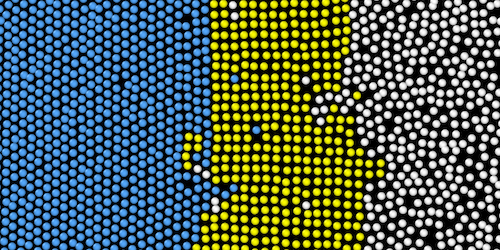Watching Crystallization Advance
The way atoms of a crystallizing liquid rearrange into a rigid lattice influences the solid’s structure and properties. It’s also challenging to observe. Now Yilong Han of the Hong Kong University of Science and Technology and his colleagues have succeeded in tracking crystallization in real time, using a model system based on colloidal particles [1]. They discovered that, depending on how the system cooled, the advancing crystallization front could form a two-phase crystalline layer.
Han and his colleagues used polymer microspheres suspended in an aqueous dye solution. For reasons that remain unclear, the dye endows the microspheres with a temperature-dependent attractive force. The microspheres’ radius also depends on temperature. When the ambient temperature falls, the microspheres become more crowded, the attractions become stronger, and controllable crystallization ensues.
The team poured the colloidal mixture into a transparent, rectangular tank and recorded video of the crystallization from above. Lowering the temperature through the freezing point led to the expected close-packed hexagonal lattice. But when the temperature was lowered further, a so-called interzone formed between the advancing hexagonal front and the liquid. It consisted of microspheres in a looser-packed square lattice. This two-step freezing process is equivalent to the formation of a liquid film on ice—called a premelting layer—but representing the reverse process. Indeed, established premelting theory reproduced the logarithmic dependence of the interzone thickness on temperature that the researchers observed. Surprisingly, the interzone thickness could reach 50 lattice constants, much wider than seen in premelting layers. Also surprising and potentially useful was that the interzone appeared to reduce the number of defects in the final crystal, offering a route toward defect-free synthesis.
–Charles Day
Charles Day is a Senior Editor for Physics Magazine.
References
- M. Li et al., “Polymorphic crystalline layer at the crystallization front,” Phys. Rev. Lett. 133, 248202 (2024).




